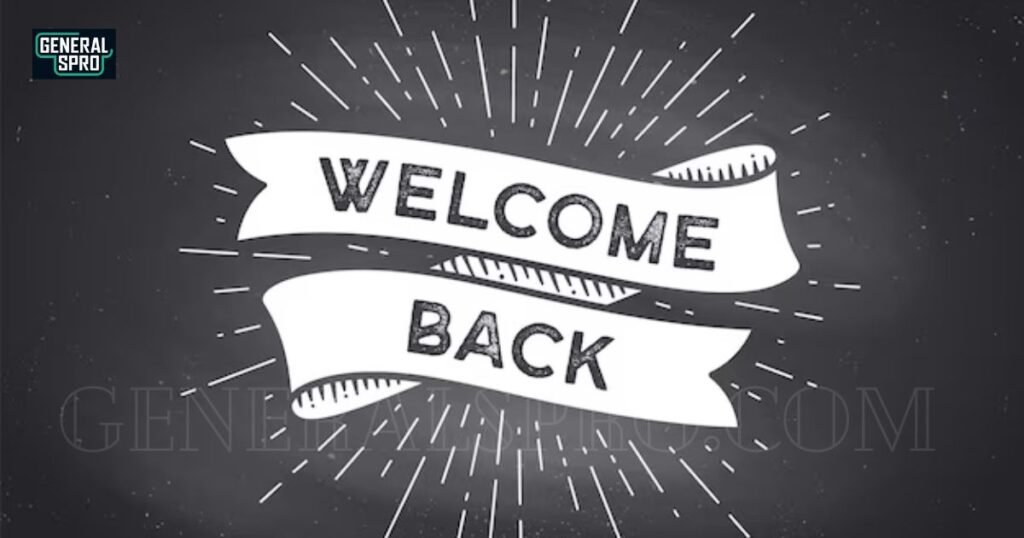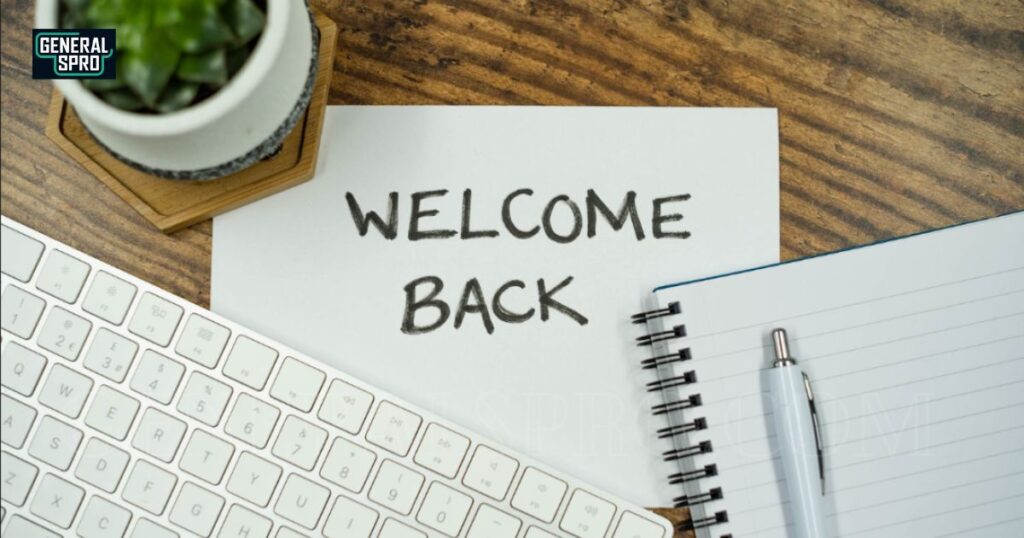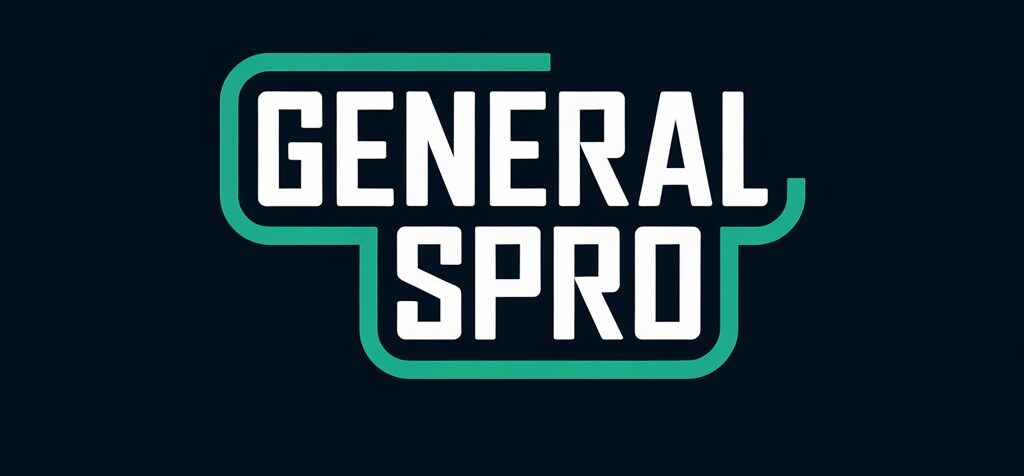Have you ever wondered how to make someone feel truly special when they return? Whether greeting a colleague after a vacation or welcoming back a valued customer, the right words can transform a simple hello into a meaningful moment of connection.
Let’s explore professional and casual alternatives to the classic “welcome back” that will help you create warmer, more engaging interactions.
Is It Professional to Say “Welcome Back”?

The traditional “welcome back” certainly has its place in professional settings, serving as a reliable standby in many workplace situations.
However, modern workplace culture increasingly values authenticity and personal connection, making expanding your repertoire of greeting expressions worthwhile.
The key lies in understanding when to maintain formality and when a more personalized approach might better serve your professional relationships.
Consider these factors when choosing your greeting:
- The organizational culture and level of formality
- Your relationship with the returning person
- The length and reason for their absence
- The presence of others during the interaction
What To Say Instead of “Welcome Back”
Let’s explore twelve thoughtful alternatives that can help you express genuine warmth while maintaining professionalism. Each phrase has its own subtle nuances and perfectly fits different contexts.
Great to see you again
This warm expression strikes an ideal balance between professional and personal. It acknowledges the person’s return while emphasizing the positive impact of their presence.
Perfect for team meetings or when encountering colleagues in shared spaces, this phrase opens the door for natural conversation.
Example contexts:
- After a colleague returns from parental leave
- When a regular client visits your office
- During team reunions after remote work periods
So lovely to have you here again
This welcoming phrase communicates genuine appreciation for someone’s return while maintaining professional boundaries.
It works exceptionally well in customer service scenarios or when greeting team members after extended absences.
I’m happy you returned.
A simple yet impactful expression that conveys personal warmth without overstepping professional boundaries.
This phrase works particularly well in one-on-one interactions where you want to sincerely appreciate someone’s return.
Welcome home
This phrase, reserved for situations where a strong sense of belonging exists, can make returning team members feel especially valued.
It’s particularly effective in close-knit work environments or when welcoming back long-term employees.
Understanding the Psychology of Welcome Phrases
When someone returns to a familiar setting, the words we choose can significantly impact their emotional state and sense of belonging.
Research in workplace psychology shows that personalized welcome messages can increase engagement by up to 23%. The proper greeting creates an immediate connection, setting the tone for positive interactions that follow.
Cultural Considerations in Welcome Expressions
Different cultures approach welcome-back greetings with varying levels of formality and emotional expression. In American business culture, while maintaining professionalism, there’s generally room for warmth and personality in greetings.
Understanding these cultural nuances helps navigate international business relationships more effectively.
Digital Welcome-Back Messages: Best Practices
Crafting the perfect welcome-back message for digital platforms requires special consideration in our increasingly virtual world.
Whether it’s an email, chat message, or video call greeting, digital welcomes must compensate for the lack of physical presence with carefully chosen words and appropriate formatting.
Seasonal and Special Occasion Return Greetings
Different seasons and occasions call for specialized welcome-back phrases. From post-holiday returns to new fiscal year beginnings, tailoring your greeting to the specific timing adds relevance and thoughtfulness to your welcome.
Team-Based Welcome Strategies
When welcoming back team members, consider both individual and group dynamics. Group welcomes require different approaches than one-on-one greetings, especially in maintaining team cohesion and motivation.
Welcome Back After Challenging Circumstances

Sometimes, people return after difficult situations like medical leave or personal challenges. In these situations, extra sensitivity and care must be taken, and welcome-back phrases must be chosen that acknowledge their return without discomfort.
Building Rapport Through Return Greetings
Strategic use of welcome-back phrases can strengthen professional relationships over time. Each return interaction presents an opportunity to deepen connections and demonstrate genuine interest in colleagues’ experiences.
Industry-Specific Welcome Protocols
Different industries have developed their own welcome-back customs and expectations. Healthcare, education, and corporate environments have unique considerations for appropriate return greetings.
The Role of Body Language in Welcome Messages
Non-verbal cues play a crucial role in how welcome-back messages are received. Proper posture, facial expressions, and gestures can enhance the sincerity of your verbal greeting.
Incorporating Feedback Into Welcome Practices
Regular assessment of how your welcome-back messages are received can help refine your approach. Collecting formal and informal feedback helps develop more effective greeting strategies.
Technology Integration in Welcome Processes
Modern workplace tools offer new ways to enhance welcome-back experiences. From automated reminder systems to personalized digital welcome cards, technology can support more consistent and thoughtful return greetings.
Training Teams in Welcome Protocols
Developing standardized yet flexible welcome-back protocols helps ensure consistency across organizations while maintaining authenticity in individual interactions.
Measuring the Impact of Welcome Strategies
Organizations can track the effectiveness of their welcome-back approaches through various metrics, including employee satisfaction surveys and retention rates. This data helps refine welcome protocols over time.
Future Trends in Professional Greetings

Emerging workplace trends suggest evolving expectations for professional greetings. Understanding these trends helps organizations stay ahead in creating welcoming environments that meet contemporary standards.
Legal and Policy Considerations
Some industries have specific requirements or restrictions regarding welcome-back protocols, particularly in healthcare or educational settings. Understanding these requirements ensures compliance while maintaining warmth in greetings.
FAQ’s
How long should I wait before saying “welcome back” to someone?
Generally, it’s best to greet someone within the first few moments of their return. However, if they appear busy or preoccupied, wait for a natural break in their activities to extend your welcome.
Is it appropriate to ask about someone’s absence when welcoming them back?
Unless you’re their direct supervisor or close colleague, it’s best to let them volunteer information about their absence. Focus instead on expressing genuine pleasure at their return.
Can I use welcome-back alternatives in formal emails?
Yes, many options work well in formal written communication. Choose phrases matching your company’s tone and relationship with the recipient.
Should I welcome someone back if they’ve been gone for a day?
A simple acknowledgment of their return is appropriate for short absences. Choose lighter phrases like “Good to see you today” rather than formal welcome-back expressions.
How can I make my welcome-back message stand out in a group setting?
Add a personal touch by referencing a shared experience or project you’re working on together. This shows thoughtfulness while maintaining professional boundaries.
Is it necessary to welcome back remote workers who return to virtual meetings?
Yes, acknowledging returns in virtual settings helps maintain team cohesion. A brief welcome at the start of the meeting allows everyone to feel included.
What’s the best way to welcome back a team member after a long absence?
Combine a warm verbal greeting with practical support, like offering to help them catch up on projects. This shows both personal and professional consideration.
Should different departments coordinate their welcome-back approaches?
While consistency in basic protocols is helpful, it allows for natural variations in greetings based on team dynamics and individual relationships.
Conclusion
Mastering the art of welcoming people back is more than memorizing phrases—it’s about understanding the subtle nuances of professional communication and human connection.
Expanding your repertoire of greeting expressions can create more meaningful interactions that strengthen professional relationships while maintaining appropriate boundaries.
Practice incorporating these alternatives naturally, creating warmer, more engaging professional interactions.








